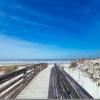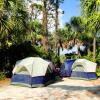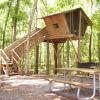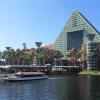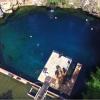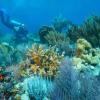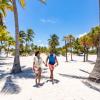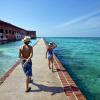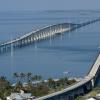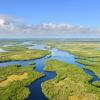Bike your way around the state. From scenic trails to cross-state greenways, here are Florida's must-see biking areas.
Boasting thousands of miles of off-road trails, paved pathways and scenic country roads, Florida's cycling options are endless. That said, there are a few must-rides that all cyclists - from beginners to race-ready veterans - should make part of their Sunshine State itinerary.
Beginning in the northeast corner of the state, the Jacksonville-Baldwin Trail offers an excellent introduction to Florida cycling, blending urban convenience with Old Florida scenery. Start peddling the 14.5-mile paved trail at the Imeson Road Trailhead, just a few miles west of downtown Jacksonville. The gently rolling pathway meanders through pine flatwoods, wetlands and hardwood canopies that provide both shade and seclusion. In addition to the flora and fauna - hawks, wild turkey and deer, to name a few - the Jacksonville-Baldwin trail also traverses McGirts Creek, site of a Confederate Civil War camp.
Just an hour or two to the southwest, the Gainesville-Hawthorne Trail offers more scenic paved cycling. This well-traveled trail winds from the city of Gainesville through Paynes Prarie Preserve State Park and into the Lochloosa Wildlife Management Area, ending on the outskirts of Hawthorne. The trail's hills provide challenging climbs and exhilarating downhills, as well as panoramic views of Paynes Prairie, where cyclists should keep an eye out for wild horses, bison and sandhill cranes. A spur trail near the Gainesville trailhead leads to the wildflower-covered Alachua sink, home to a mind-boggling number of alligators.
Continuing west, natural springs begin to outnumber cities and cyclists eventually reach the Nature Coast Trail. One of the state's most beautiful rails-to-trails projects, the 32-mile paved pathway connects the rural communities of Chiefland, Trenton, Fanning Springs, Old Town and Cross City. A "T" shape, the Nature Coast Trail can be ridden in several configurations. Starting at the old train depot in Cross City, riders can peddle east toward Old Town where they'll cross the lazy Suwannee River on a historic train trestle. Cyclists may continue east to Trenton or head south. The southern route leads directly past Fanning Springs State Park, the perfect place to take a break and cool off swimming or snorkeling the crystal-clear springs.
Florida's longest continuous rail-trail begins less than an hour south near the small town of Dunnellon. The Withlacoochee State Trail is as fun to cycle as it is to pronounce, running 46 miles south to Trilby. While "Withlacooche" translates to "crooked river," the trail itself is relatively straight, passing through the pristine, 150,000-acre state forest by the same name. Running past ranches, small towns and wildlife-rich preserves, the pathway also serves as a gateway to other recreational pursuits. The fat tire crowd will want to challenge the 50-plus miles of the Croom Off-Road Trail, while paddlers should check out the 83-mile canoe trail.
Just to the south, visitors will find one of Florida's best urban trails. The Pinellas Trail runs 47 miles, traversing natural areas, charming downtowns and urban centers. From the south, the trail begins just outside downtown St. Petersburg, the cultural center of Florida's West Coast. Winding north through neighborhoods and across intracoastal waterways, riders reach the quaint Scottish town of Dunedin. A scenic trail leads to Honeymoon Island State Park, where cyclists can catch a ferry to the award-winning beaches of Caladesi Island. The trail ends in Tarpon Springs, where tired road warriors may reward themselves with an authentic Greek meal and a stroll around the historic sponge docks.
For the serious cyclists, nothing can top the challenge of biking coast-to-coast on one of Florida's cross-state trails. The Marjorie Harris Carr Cross Florida Greenway is among the most beautiful of these trails, traversing 110 miles of swamps, rolling hills and dense forests. Built largely along the failed Cross Florida Barge Canal, nature and history come in equal doses on this trail, which runs from Inglis east to the St. John's River. Innumerable side trails offer off-road adventure and exploration, and abundant wildlife habitat affords the chance to see Florida black bears, deer, alligators and even manatees.

